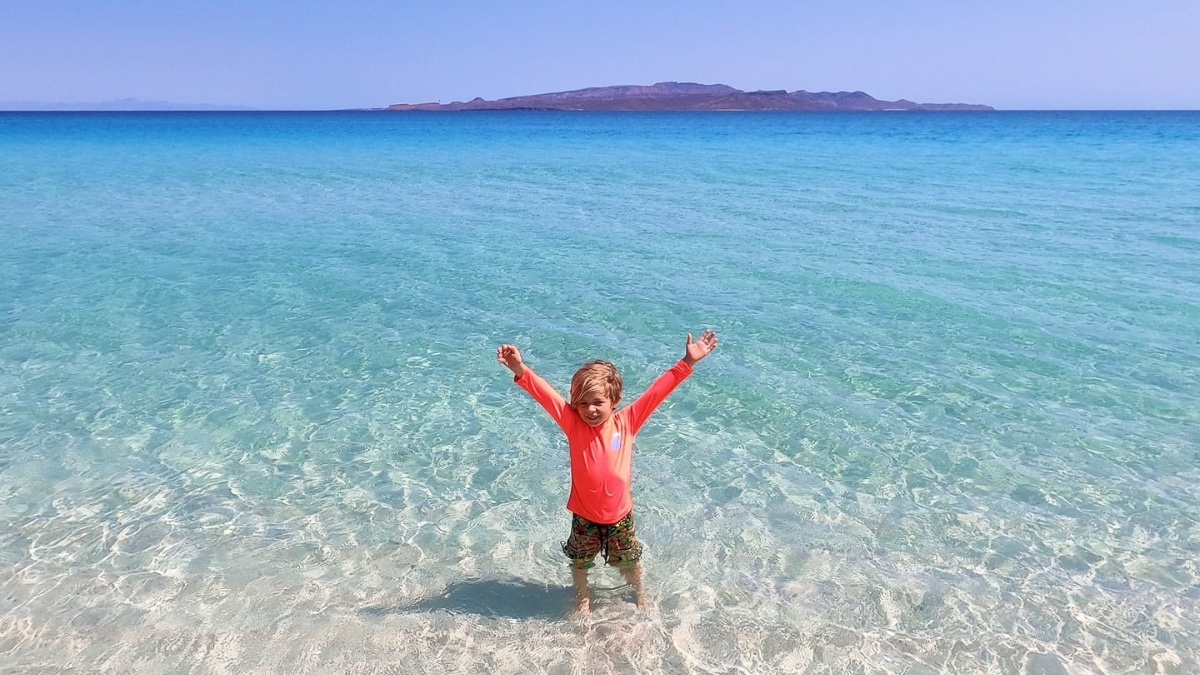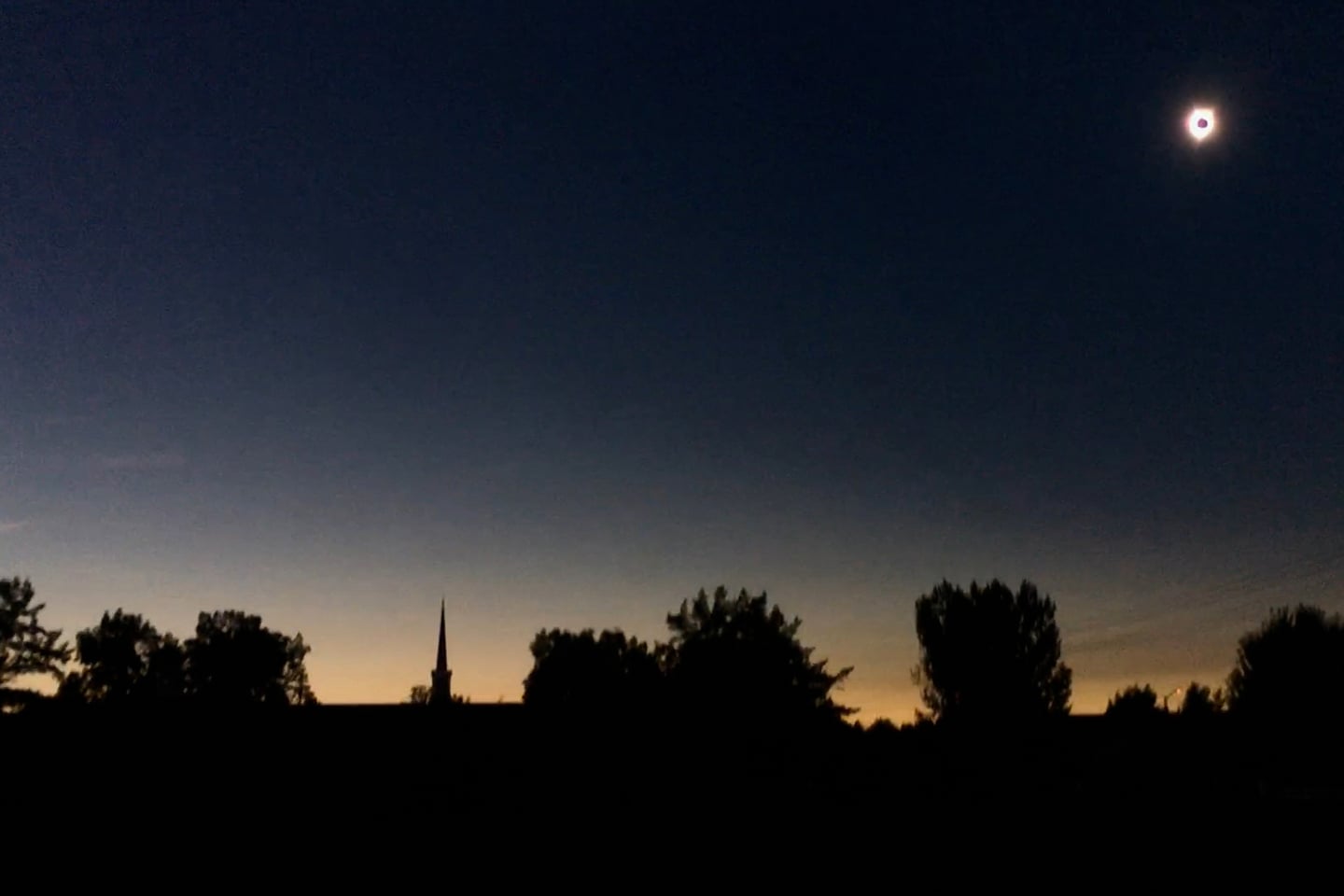In early February in the depths of the Oregon winter, Lori and I roughly sketched out the first month of our route through Mexico. We were itching to get deep enough into Mexico where the water temps would be warm enough to swim and we could ditch the jeans and get back to wearing our real clothes.
To do this, however, meant juggling staying on the beach in Mexico during the busiest time of year: Semana Santa and Semana Pascua.
Fine, we thought. We’d hang out in San Carlos, then head south after Easter. But this year, there was another big event on the heels of the Easter holiday: A total eclipse.
And the Path of Totality ran straight through Mazatlan, basically where we were headed.
I happened to catch the 2017 solar eclipse in the Path of Totality in Oregon and would have loved to repeat the experience and share it with the rest of the family.
But given the worldwide buzz around this year’s eclipse, and that Mazatlan would be the first place the eclipse makes landfall in North America, it looked like it might be a bit too hectic for figuring out all the logistics with a 25-foot RV.
So, we put all our efforts into avoiding the Path of Totality. However, after our sand storm experience cut our time at El Mirador short, we had no other choice but to keep heading south.
We thought that the RV park we were eying just north of the Path of Totality would be packed, but somehow it wasn’t at all. Apparently, there was a caravan coming up from Mazatlan after the eclipse, but they had vacancies for the day of the eclipse.
So, that’s where we ended up. And as it happens so often in Mexico, they were able to find a space for us for as long as we wanted to stay.

In Mexico, highways rarely have two lanes going in each direction. If you’re lucky, what they will have is a wide shoulder. Slower vehicles (like us) are expected to drive down the middle of the white line while the rest of the road becomes passing area.

It works beautifully in situations like the picture above, where there aren’t a lot of other cars and the shoulder is reliable and roomy. However, it can be nerve-racking when there are trucks passing trucks in both directions and your shoulder suddenly disappears.

The drive between Las Glorias and Celestino was anything but straight-forward. The route was confusing and Google maps failed us twice. We should have known better.
The second time, our route suddenly turned from pavement to a dirt road, which narrowed and ended up in a corn field. We asked directions and eventually found our way back to the main highway and headed south.


While trying to get back to the highway, we also had to contend with lots of low-hanging branches and hidden topes (speed bumps).
If that weren’t enough, Lori and Noe were both having severe stomach issues (presumably from the strawberry creamsicles they got in Las Glorias the day before). Lori was in no condition to help me navigate and Noe was doing a bang-up job of keeping his lap-bucket loaded.
The only redeeming aspect of the entire day’s trip was this guy.

Yep, those are ‘fro wigs he’s selling at the toll plaza. I have no words…

After the ‘fro-ballero, it was smooth sailing on some really nice roads. I was impressed.


You guessed right—that’s a truck full of pigs. And heck yes, it smells worse than it looks.
Which brings me to a big beef I have with our Ford Econoline chassis. We’ve had a great experience so far and I appreciate the simplicity of the controls. But for the life of me I can’t seem to figure out why they designed the A/C controls like they did.
If you select fan or heater, you have the usual options of vent/floor/defrost. But for A/C, it uses all of the above all at once. And, even worse, there’s no ‘recycle air’ option for anything. If you’ve got a burning field (or a truck full of pigs) in front of you, you can bet your entire home is going to be smelling like that for a while.

We eventually made it to Villa Celeste. Lori and Noe spent the remainder of the evening resting, and Riley wants to be where Noe is these days.
I needed to stretch my legs and get some fresh air. I headed down to the beach solo and caught a pretty spectacular sunset.

The next day was Eclipse Day. When we awoke, we still didn’t know if we’d be able to get into the path of totality or if we could get our hands on eclipse glasses.
At the last minute, Lori rounded up four pairs of glasses, so we headed south to a random spot on the map, just inside the Path. It was a pretty rough looking little settlement just off the main highway without a soul around.
It would have done the job, but what I really wanted was to try and make it to a nearby archeological site. Lori was hesitant thinking that it would be next to impossible to find a spot to park our large vehicle this close to the big event.
I looked at the map and it appeared we could park in a nearby village, then walk two miles to the site. It was worth a try.

We followed a big coach bus down a dusty road into the village, parked, and covered the remaining distance on foot.

About twenty minutes away from the site, we saw the first of a long line of cars parked along the road, stretching for over a kilometer. We made the right choice parking back in the village, it seems.

There were license plates from all across Mexico—Mexico City, Oaxaca, and beyond. And not a single car from the U.S.

We made it to Las Labradas with just under 30 minutes to spare. We continued on to the beach.


Easily a few hundred people lined the beach. Still, it wasn’t hard to find a nice little spot just off the path.
We saw just two other gringo-looking people the whole time. Here at Las Labradas today, the eclipse was an overwhelmingly Mexican affair. I have a hunch in Mazatlan, things were a bit different.



The countdown begins.


Then, shortly after 11am local time, with the sun high in the sky, everything around us darkened, and the eclipse was upon us—met with rousing cheers from the surrounding crowd.




In the now two times I’ve experienced this, it’s not so much the darkness that is most striking (though it is striking, especially when the stars come out in the middle of the day), but the onslaught on the senses. The wind kicks up, the temperature drops, birds start calling out and taking flight.
And here at Las Labradas in the path of totality, just 40 miles north of bustling Mazatlan, we got to enjoy the spectacle for a full four minutes, eclipses (pun intended) my 2017 record by more than four-fold.

I wasn’t sure what the boys would make of all of this, or if they’d be able to grasp the significance of the moment (or our sheer luck in being able to witness it). Once the sky darkened and the stars came out, they went nuts, and are still talking about the eclipse days later.


To be here for this very special celestial event was exciting. To have landed on this specific place, last minute and unplanned was particularly special.
Las Labradas is a sacred site for many indigenous people in the area, largely owing to its ancient petroglyphs carved into stones on the beach dating back more than 1,000 years. In recent years, UNESCO’s added it to their tentative list of world heritage sites.
No one knows why or how the petroglyphs got here. But people for generations have flocked to this place during events like these. Of the many petroglyphs, there’s even one believed to be a total solar eclipse—the coincidence was not lost on us or the hundreds of people who came here today to experience this special moment.

Then, just like that, it was over. People filed out and we went to go take a closer look at the petroglyphs.




That round one on the rock to the left of the white squiggly is thought by archeologists to be an eclipse. The indigenous people of the area also agree.

The boys are already talking about the next total solar eclipse, which isn’t due in the Lower 48 U.S. states for another two decades (and in Mexico for three decades). I’d like to think this one will stick with them for a while, regardless.



